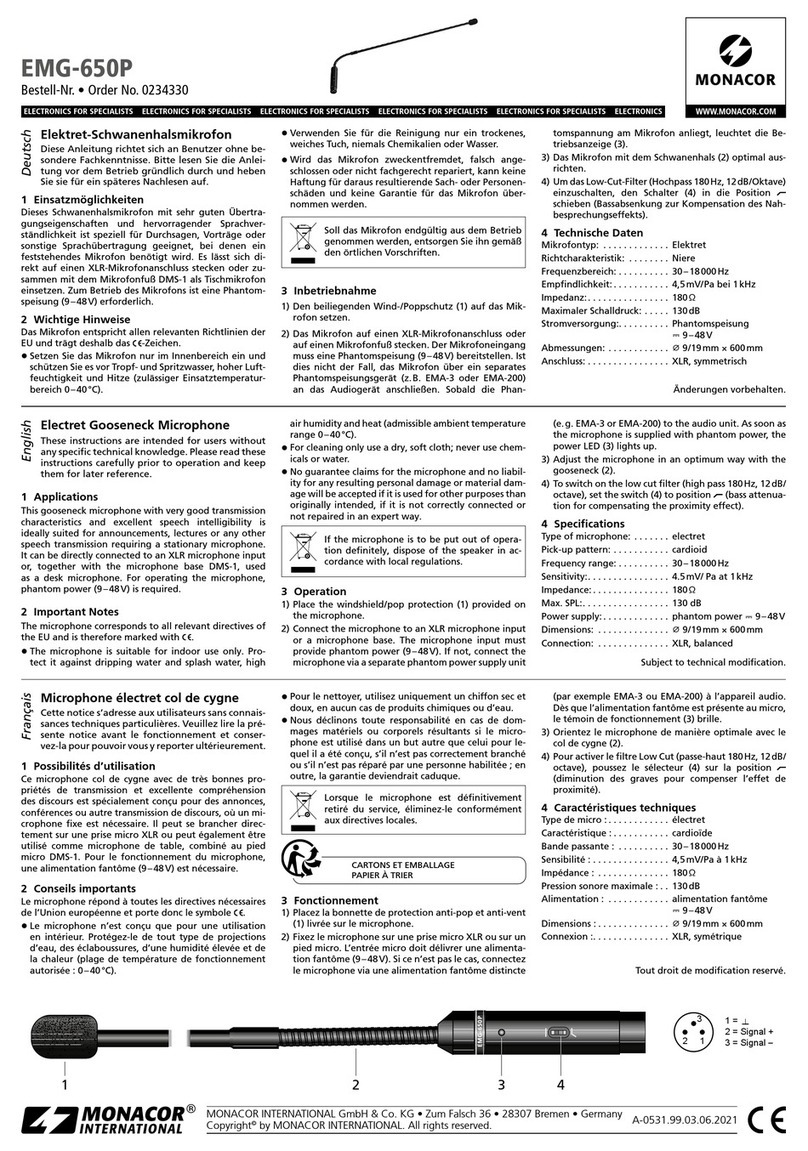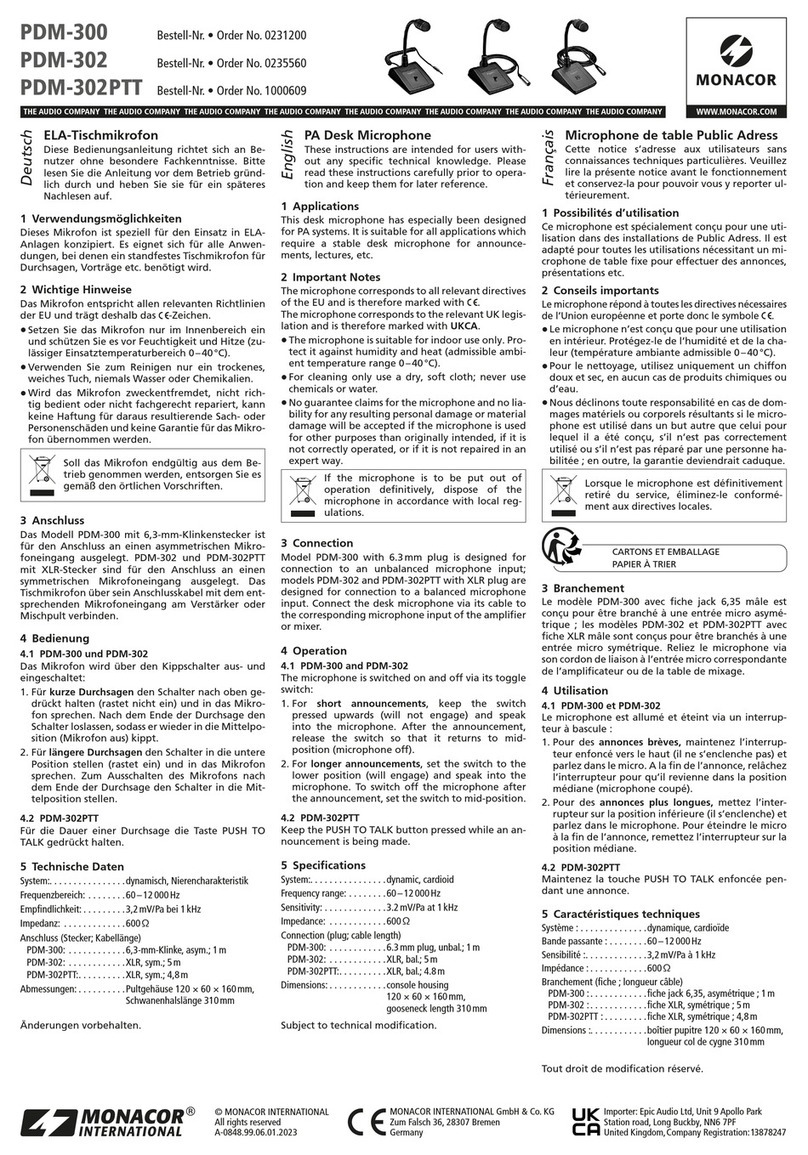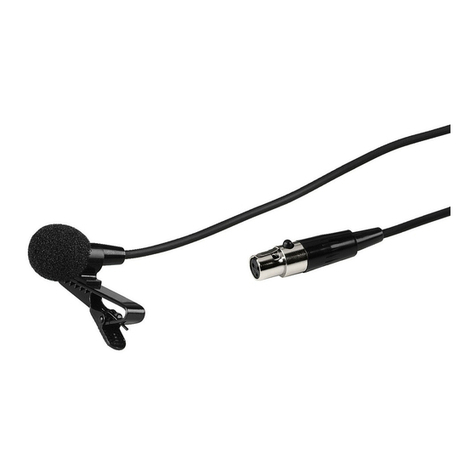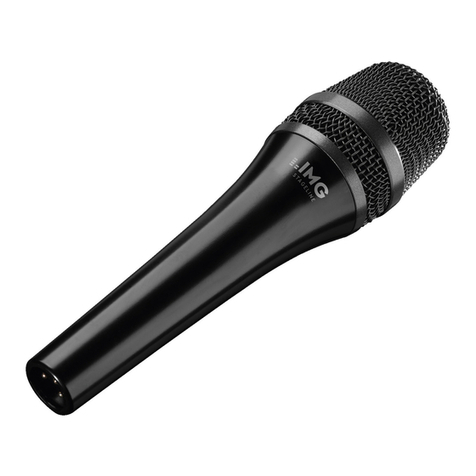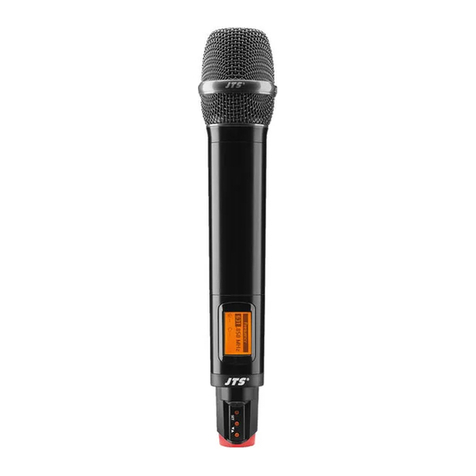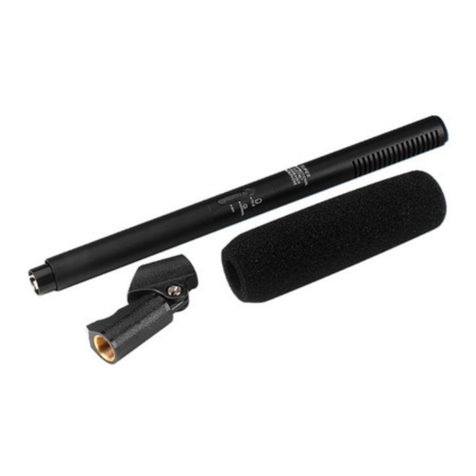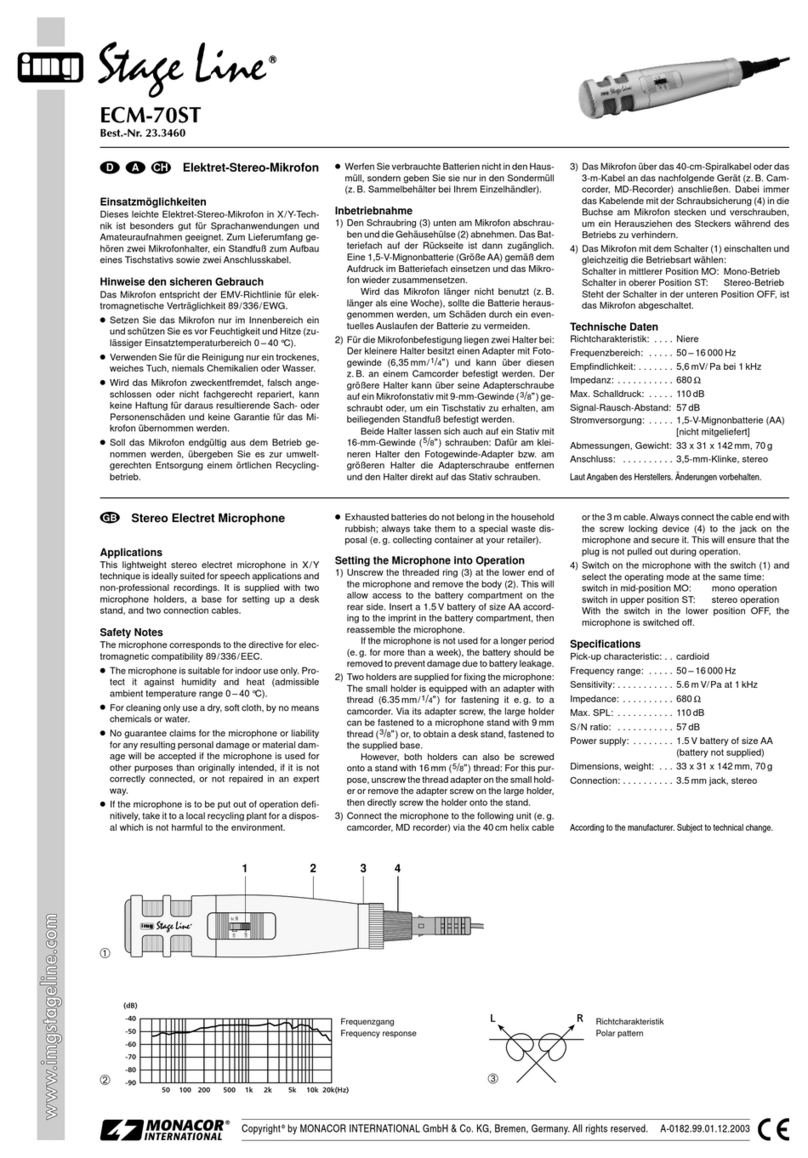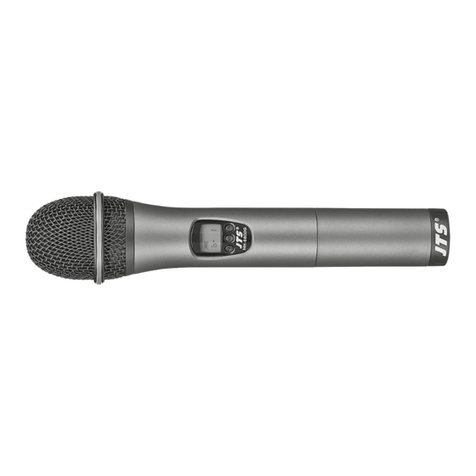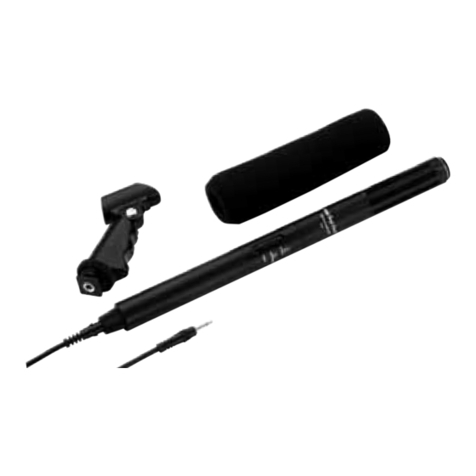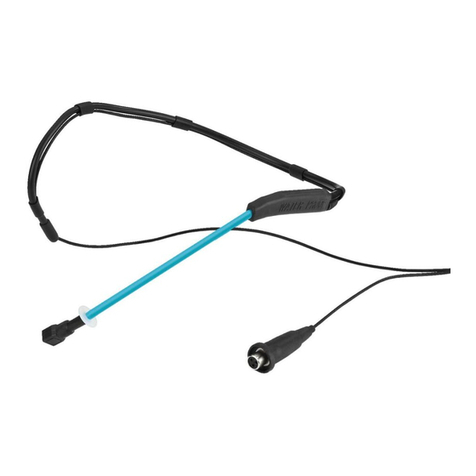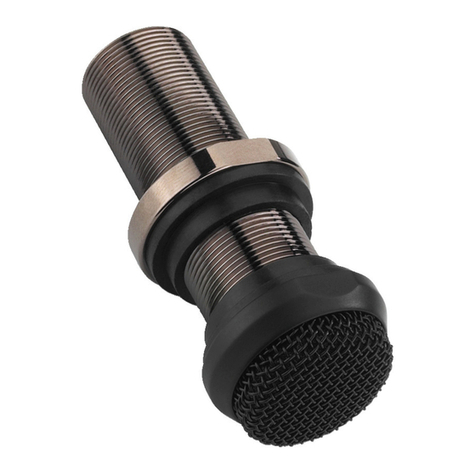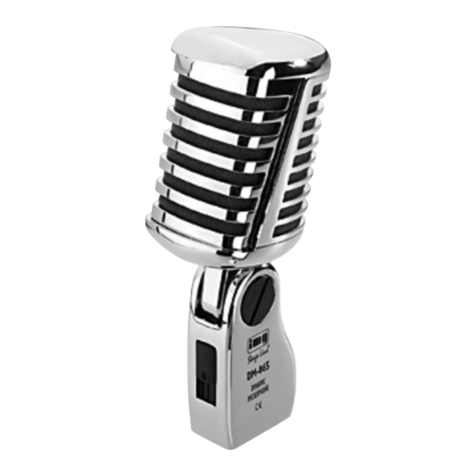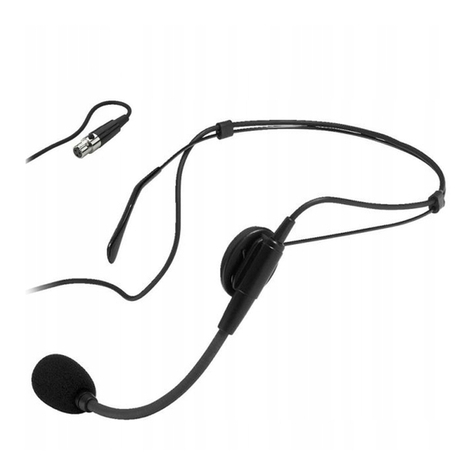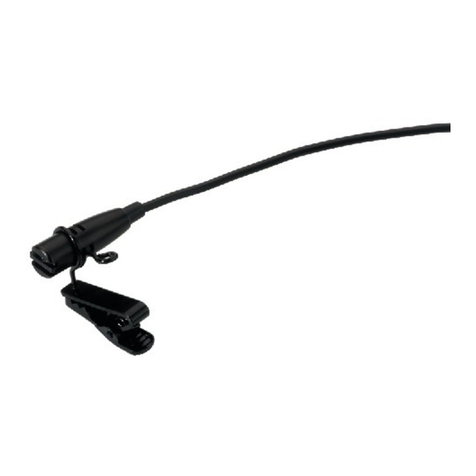
Microphone à condensateur
avec rande membrane
Veuillez lire la présente notice avec attention avant
le fonctionnement et conservez-la pour pouvoir vous
y reporter ultérieurement.
1 Possibilités dʼutilisation
Ce microphone à condensateur avec une mem-
brane 25,4 mm (1") extrêmement fine et à revête-
ment or, est conçu pour des utilisations profession-
nelles en studio et en direct. Il est tout aussi bien
adapté pour des prises de son dʼinstruments que
pour des applications de chant et discours. Pour le
fonctionnement, le microphone requiert une alimen-
tation fantôme de 48 V.
Sont livrés un coffret et un support atténuateur de
vibrations (araignée).
2 Conseils dʼutilisation importants
Le microphone répond à toutes les directives né-
cessaires de lʼUnion européenne et port donc le
symbole .
GLe microphone nʼest conçu que pour une utilisa-
tion en intérieur. Protégez-le de lʼhumidité et de la
chaleur (plage de température de fonctionnement
autorisée : 0 – 40 °C).
GPour le nettoyer, utilisez un chiffon sec et doux,
en aucun cas de produits chimiques ou dʼeau.
Gous déclinons toute responsabilité en cas de
dommage matériels ou corporels résultants si le
Copyright©by MONACOR NTERNAT ONAL GmbH & Co. KG, Bremen, Germany. All rights reserved. A-0876.99.01.07.2008
®
ECM-180
Best.-Nr. 23.5630
wwwwww..iimmggssttaaggeelliinnee..ccoomm
microphone est utilisé dans un but autre que celui
pour lequel il a été conçu, sʼil nʼest pas correcte-
ment branché ou sʼil nʼest pas réparé par une per-
sonne habilitée ; en outre, la garantie deviendrait
caduque.
3 Fonctionnement
1) Vissez le support du microphone sur un pied doté
dʼun filetage 15,9 mm (5⁄8"). Pressez les deux
étriers à fil sur le support et insérez le micro-
phone.
2) Pour orienter le microphone, desserrez la vis de
réglage sur le support. Positionnez le micro-
phone de telle sorte que le côté avec le symbole
soit en direction de la source sonore. Puis re-
vissez la vis.
3) Reliez le microphone via un cordon avec fiche
XLR mâle (par exemple un cordon de la série
MEC de “img Stage Line”) à une entrée micro de
lʼappareil audio utilisé (par exemple table de mixa-
ge). Lʼentrée micro doit avoir une alimentation
fantôme 48 V. Si lʼappareil audio ne délivre pas
dʼalimentation fantôme, reliez le microphone via
un appareil à alimentation fantôme (par exemple
EMA-3 de “img Stage Line”) à lʼappareil audio.
Lorsque le microphone est définitivement
retiré du service, vous devez le déposer
dans une usine de recyclage adaptée pour
contribuer à son élimination non polluante.
4) Une protection anti-pop disponible en option (par
exemple WS-100 de “img Stage Line”) empêche
lors dʼapplications de chant ou de discours, non
seulement une accentuation excessive de sons
explosifs mais protège aussi le microphone de
lʼhumidité de la respiration.
4 Caractéristiques techniques
Système : . . . . . . . . . . . . . . récepteur à gradient de pres-
sion/cardioïde
Sensibilité : . . . . . . . . . . . . . 13 mV/Pa à 1 kHz
mpédance : . . . . . . . . . . . . 200
Ω
Pression sonore max. : . . . . 130 dB pour taux de distorsion
0,5 %
Rapport signal/bruit : . . . . . 79 dB (filtre A)
Alimentation : . . . . . . . . . . . alimentation fantôme 48 V ±4 V
Branchement : . . . . . . . . . . XLR, symétrique
Configuration contacts :
1= blindage/alimentation fantôme
-
2= signal+/alimentation fantôme +
3=signal
-
/alimentation fantôme +
Dimensions : . . . . . . . . . . . . ∅60 mm ×150 mm
Poids : . . . . . . . . . . . . . . . . . 470 g
Tout droit de modification réservé.
Microfono a condensatore
a rande membrana
Vi preghiamo di leggere attentamente le presenti
istruzioni prima della messa in funzione e di con-
servarle per un uso futuro.
1 Possibilità dʼimpie o
Questo microfono a condensatore con la sua mem-
brana di 25,4 mm (1"), estremamente sottile, placata
dʼoro, è stato realizzato per impieghi professionali
negli studi di registrazione e dal vivo; è adatto sia
per prelevare il suono da strumenti musicali che per
applicazioni di canto e di lingua parlata. Per il fun-
zionamento, il microfono richiede unʼalimentazione
phantom di 48 V.
Il kit comprende una valigetta e un supporto del
microfono che riduce le vibrazioni (spider).
2 Avvertenze importanti
Il microfono è conforme a tutte le direttive richieste
dellʼUE e pertanto porta la sigla .
GUsare il microfono solo allʼinterno di locali. Pro-
teggerlo dallʼ umidità e dal calore (temperatura
dʼimpiego ammessa fra 0 e 40 °C).
GPer la pulizia usare solo un panno morbido,
asciut to; non impiegare in nessun caso prodotti
chimici o acqua.
Gel caso dʼuso improprio, di collegamenti sbagliati
o di riparazione scorretta del microfono, non si as-
sume nessuna responsabilità per eventuali danni
consequenziali a persone o a cose e non si as-
sume nessuna garanzia per il microfono.
3 Messa in funzione
1) Avvitare il supporto microfono su uno stativo con
filettatura di 15,9 mm (5⁄8"). Esercitare una pres-
sione sulle due staffe di filo di ferro dello spider ed
inserire il microfono.
2) Per orientare il microfono, allentare la vite di bloc-
caggio del supporto, posizionare il microfono in
modo che il lato con il simbolo sia indirizzato
verso la sorgente sonora e stringere di nuovo la
vite.
3) Collegare il microfono con un ingresso microfono
dellʼapparecchio audio utilizzato (p. es. di un
mixer), servendosi di un cavo con connettori XLR
(p. es. un cavo della serie MEC di “img Stage
Line”). Lʼingresso deve essere equipaggiato con
un alimentazione phantom di 48 V. Se lʼappa-
recchio audio non dispone di alimentazione
phantom, occorre collegare il microfono con lʼap-
parecchio audio per mezzo di un alimentatore
phantom esterno (p. es. EMA-3 di “img Stage
Line”).
4) Un dispositivo antivento (p. es. WS-100 di “img
Stage Line”) disponibile come accessorio, es-
Se si desidera eliminare il microfono defi-
nitivamente, consegnarlo per lo smalti-
mento ad unʼistituzione locale per il rici-
claggio.
clude nella lingua parlata e nel canto non solo la
riproduzione esagerata delle consonanti occlu-
sive, ma protegge il microfono anche dallʼumidità
del respiro.
4 Dati tecnici
Sistema: . . . . . . . . . . . . . . . microfono a gradiente di pres-
sione, a cardioide
Sensibilità: . . . . . . . . . . . . . 13 mV/Pa con 1 kHz
mpedenza: . . . . . . . . . . . . . 200
Ω
Max. pressione sonora: . . . 130 dB con fattore di distorsione
0,5 %
Rapporto S/R: . . . . . . . . . . . 79 dB (filtro A)
Alimentazione: . . . . . . . . . . phantom 48 V ±4 V
Connessione: . . . . . . . . . . . XLR, simmetrica
Contatti:
1 = schermatura/alimentazione phantom
-
2 = segnale +/ alimentazione phantom +
3 = segnale
-
/ alimentazione phantom +
Dimensioni: . . . . . . . . . . . . . ∅60 mm × 150 mm
Peso: . . . . . . . . . . . . . . . . . . 470 g
Con riserva di modifiche tecniche.
F
I
Réponse en fréquence
Risposta in frequenza
Diagramme polaire (à 1 kHz)
Diagramma direttivo (con 1 kHz)


